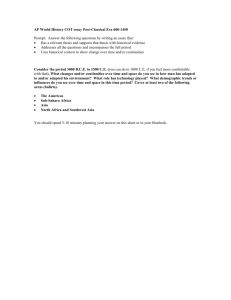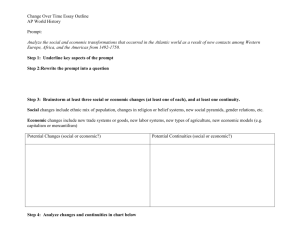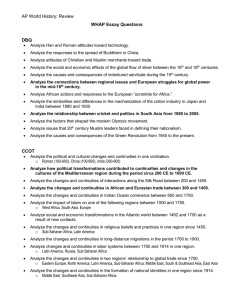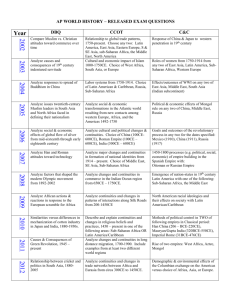S CCOT E Q
advertisement
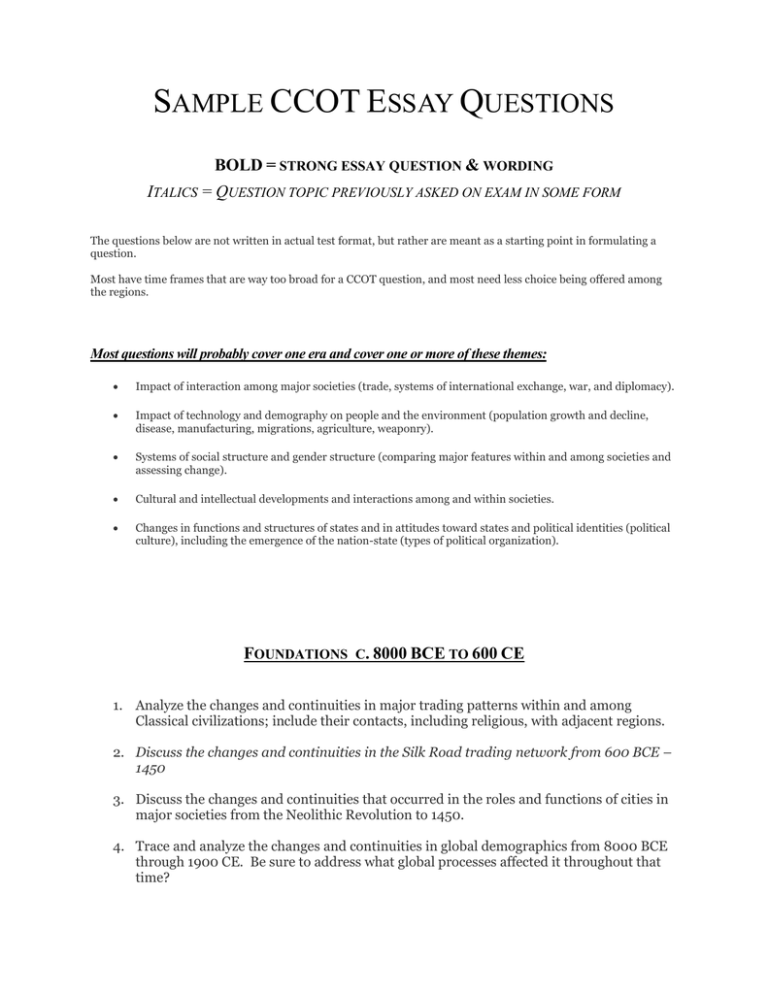
SAMPLE CCOT ESSAY QUESTIONS BOLD = STRONG ESSAY QUESTION & WORDING ITALICS = QUESTION TOPIC PREVIOUSLY ASKED ON EXAM IN SOME FORM The questions below are not written in actual test format, but rather are meant as a starting point in formulating a question. Most have time frames that are way too broad for a CCOT question, and most need less choice being offered among the regions. Most questions will probably cover one era and cover one or more of these themes: Impact of interaction among major societies (trade, systems of international exchange, war, and diplomacy). Impact of technology and demography on people and the environment (population growth and decline, disease, manufacturing, migrations, agriculture, weaponry). Systems of social structure and gender structure (comparing major features within and among societies and assessing change). Cultural and intellectual developments and interactions among and within societies. Changes in functions and structures of states and in attitudes toward states and political identities (political culture), including the emergence of the nation-state (types of political organization). FOUNDATIONS C. 8000 BCE TO 600 CE 1. Analyze the changes and continuities in major trading patterns within and among Classical civilizations; include their contacts, including religious, with adjacent regions. 2. Discuss the changes and continuities in the Silk Road trading network from 600 BCE – 1450 3. Discuss the changes and continuities that occurred in the roles and functions of cities in major societies from the Neolithic Revolution to 1450. 4. Trace and analyze the changes and continuities in global demographics from 8000 BCE through 1900 CE. Be sure to address what global processes affected it throughout that time? 5. Trace and analyze the changes and continuities in the environments of two of the regions of the world from 8000 BCE to present. Europe Sub-Saharan Africa the Middle East East Asia SE Asia South Asia Latin America North America 6. Analyze the changes and continuities in China from the Zhou to the Song. Be sure to address political, social and economic factors as well as outside influences. 7. Trace and analyze the evolution of slavery and serfdom from prehistoric times to the end of the 19th century in TWO of the following regions. East Asia Mediterranean Eastern Europe Sub-Saharan Africa 8. Analyze the changes and continuities in the nature of slavery from 8000 BCE to 1750 CE. 9. Discuss the continuities and changes in migrations to and within afro-Eurasia from 100 CE to 1450 CE. 10. Analyze the changes and continuities in the movements of peoples (Huns, Germans) 11. Discuss the changes and continuities in the Fur Trade from the 400s through the 1800s. 12. Analyze the changes and continuities in women's experience from the Neolithic down to 1450 CE. 13. Analyze the changes and continuities in the development of belief systems from 8000 BCE to 600 CE in one of the following regions. East Asia South Asia Mediterranean 14. Analyze the changes and continuities in the role of Afghanistan as a “Crossroad” of history from the 4th C BCE to the 21st C. 15. Analyze the change and continuities in the development of government from 8000 BCE to 600 CE. Be sure to identify the different forms and characteristics that developed. East Asia South Asia Mediterranean 16. Analyze the evolution of religious practice in one of the following belief systems. Brahmanism/Hinduism Buddhism Christianity POSTCLASSICAL 600 CE TO 1450 CE 17. Describe the evolution of various political units in Western Europe from 1000 to 1750. 18. Describe the changes and continuities in the evolution and spread of scientific and technological knowledge from 1000 to 1450 in the following two regions: Islamic Eurasia, and Central and East Asia. 19. Explain how ideas about government (the state, political structure) evolved from 1400 to 1900. What changed? What did not? 20. Discuss the changes in modes of transportation from around 700 CE to the present. Explain how the changes have impacted people, societies, and cultures. 21. Analyze the changes and continuities in two of the following examples of interregional trade, technology, cultural exchange Trans-Saharan Network Indian Ocean Network Silk routes 22. Discuss the changes and continuities in the Mongol Empire from its beginning under Genghis Khan to its demise. 23. Analyze the changes and continuities in the missionary outreach of major religions 24. Discuss the changes and continuities in the Indian Ocean trading network from 6001914. 25. Analyze the changes and continuities in African and Eurasian trade between 300 and 1450. 26. Analyze the changes and continuities in the contacts between major religions, e.g. Islam & Buddhism, Christianity & Islam 27. Analyze the changes and continuities in the rise and role of Dar al-Islam as a unifying cultural force in Eurasia and Africa from 600 to 1750 28. Analyze the changes and continuities in the impact of Islam on the arts, sciences and technologies from 600 to 1914. 29. Analyze the changes and continuities in the major disease flows across the world from the 13th C to the present. Be sure to address cause and consequences. 30. Analyze the changes and continuities in the caliphate from the early years after Muhammad until the Seljuk takeover. 31. Discuss the changes and continuities in the labor systems used in Latin America and North America from 1000 to present. 32. Describe the political evolution of various societies in ONE the regions listed below from 1000 to 1750. East Asia Western Europe Eastern Europe Southwest Asia 33. Trace the demographic and environmental changes in TWO regions of the world from 1000 CE to 2000 CE. East Asia Western Europe South America North America South Asia 34. Analyze the changes and continuities in the interactions of Islam with Christianity over time. 35. Analyze the transformations and continuities in the status of women from 600 to 1750 in the following regions. Americas Sub-Saharan Africa Southeast Asia Southwest Asia 36. Analyze the changes and continuities in the two of the following gunpowder empires from their coming to power to their ultimate decline. Be sure to examine their governments, economies and cultures. Ottomans, Safavids, and Mughals 37. Analyze the changes and continuities in Islamic influence in Africa, S.E Asia and S. Asia from 1000 to 1450 CE 38. Analyze the changes that occur in W. Europe from 1000 to 1450 CE from two of the following areas: political, economic, cultural, social, etc. RISE OF GLOBAL INTERACTION 1450 CE TO 1750 CE 39. Discuss the changes and continuities in the Atlantic Ocean trading network from 1450 to present. 40. What changes and continuities did Ottoman society exhibit in the period from 1500 to 1914? 41. Discuss the changes and continuities in labor systems, both free and unfree, from 1400 to 1914 in TWO of the following regions. Eastern Europe Americas Sub-Saharan Africa southwest Asia 42. Discuss the changes and continuities in Western Europe's outside contacts with ONE of the following areas between 1450-1914. (South Asia, East Asia, Sub-Saharan Africa) 43. Analyze the changes in the forced labor systems in the Americas from 1450 to 1914 CE. 44. Trace the development of relations between Amerindians and Europeans in North and South America from the Colombian encounters through the 19th century. 45. Analyze the economic and social changes in two of the following regions from 1450 to 1750. Western Europe East Asia Americas South Asia SubSaharan Africa 46. Discuss the changes and continuities between the first age of overseas expansion in the 16th century and the second age of overseas expansion in the 19th century. Discuss the impact on ONE of the following areas: Africa South Asia the Americas East Asia 47. Pick ONE of the following regions and discuss the change and continuities in European settlement from 1450 to 1750. Latin America Australia North America 48. Trace the development of global transportation and communication from 1450-1850. 49. Analyze the changes and continuities in demographic changes in the Americas in the period from 1450 to 1914. 50. Analyze the changes and continuities in what came to be known as Latin America from approximately 1400 CE to 1800 CE. Be sure to evaluate the causes of the changes and the reasons for the continuities. Your analysis must address at least TWO of the following aspects of pre- and post- Colombian Latin America: Political Economic Social THE LONG NINETEENTH CENTURY 1750 CE TO 1914 CE 51. Analyze the changes and continuities in the process of industrialization and the economic, social and intellectual impact in Western Europe and one of the following regions. East Asia South Asia Sub-Saharan Africa Latin American 52. Discuss the changes and continuities in the impact that technological changes have had on family structure in one of the following nations since 1750. China Japan India Great Britain 53. Assess the changes and continuities in technological development and its impact on war between 1750-1945. 54. From 1750 to the present, considerable effort was expended by nations in their search for a new identity. Select two of the nations below and evaluate the success in the forging of a new political, economic and social identity. CHINA INDIA RUSSIA JAPAN SOUTH AFRICA 55. Pick one of the following regions and discuss the changes and continuities in the production and distribution of goods and the patterns of global trade over the time period 1750-1914. Africa East Asia Latin America South Asia Western Europe 56. Analyze the changes and continuities in the role and status of women in two of the regions listed below from 1750 CE to through the present. East Asia Southeast Asia Latin America Western Europe 57. Analyze the evolution of nationalism since 1750 in ONE of the regions listed below. Eastern Europe Sub-Saharan Africa South America East Asia 58. Discuss the changes and continuities in India and Africa's relationship with the West from 1750 to the present. 59. Trace and evaluate the changes and continuities in the evolution of racism from 1750 to the present in two of the regions listed below. Include the relationship among imperialism, nationalism, and racism in showing the continuities and changes over time. Europe North America South Africa Latin America 60. Analyze the political, economic, and social continuities and changes in Latin America from approximately 1700 CE to the early 20th century. Your analysis should include an evaluation of the causes of changes and the reasons for continuities. THE POST-MODERN ERA 1914 CE TO PRESENT 61. Analyze the changes and continuities in the patterns of nationalism from1914 to the present in TWO of the following regions. Eastern Europe Sub-Saharan Africa Southeast Asia Middle East 62. Analyze the changes and continuities in science and technology from 1914 to the present. Include reactions to developments, like religious responses. 63. Analyze the changes and continuities in the forces of revolution and other sources of political innovations from 1914 to the present in TWO of the following regions. East Asia Southeast Asia Eastern Europe Latin America 64. Discuss the changes and continuities in the Pacific Rim economy from 1914 to the present. 65. Analyze the demographic and environmental changes from 1914 to the present. 66. Analyze the development in global / international organizations from 1914 to the present. 67. Analyze the changes and continuities in the practice of genocide from 1914 to the present. Be sure to include at least two examples outside of Europe. 68. Trace the changes and continuities in the development of the global economy from 1914 to the present. 69. Analyze the development of a global culture from 1914 to the present. Include regional differences and elite as well as popular forms of culture. 70. Analyze the changes and continuities in the social development from1914 to the present in TWO of the following regions. Eastern Europe North America South Asia Southeast Asia East Asia
